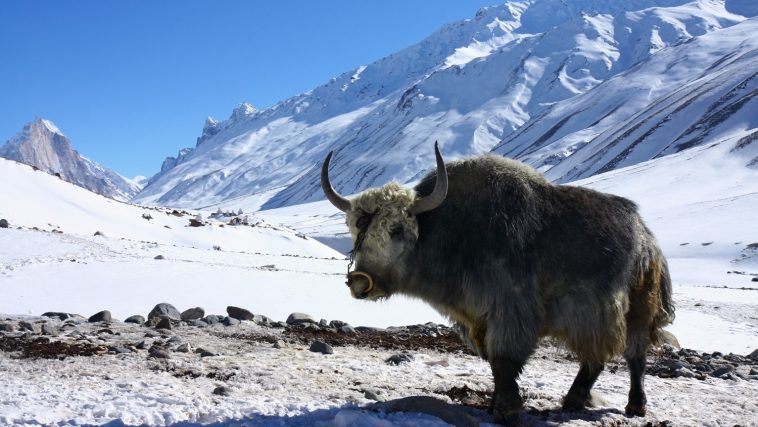Surviving at altitudes of 20,000 feet can only be done by the toughest animals. Most animals need plenty of plants to eat or lots of animals that eat those plants to hunt. Mountain slopes generally have poor, thin soil because, in many areas, the surface has been scraped off by the ice caps during the long winters and the slow melting of spring. The climate is harsh, and the growing season is short, oftentimes only 100 days or fewer. There are not many plants that can thrive in those conditions.
Winds are fierce, winters are cold, food is sparse, and the warm season to raise babies is short. Oxygen levels continuously drop the higher up the mountains you go. And travelling up the mountain slopes is hard work. If you are an animal that lives this high on the mountains, you need to have special abilities and “equipment” to survive such situations.
We are going to look at two animals that can handle these tough conditions.
The Yak
Yaks are part of the created cattle kind that includes domesticated cows that came off of the ark after the worldwide flood. Yaks are found in the Himalayan mountains and are strongly built with sturdy legs, rounded, cloven hooves, and extremely dense, long fur that usually hangs lower than the belly, with a fine undercoat.
God created the yak with special abilities to handle high altitudes. They have larger lungs and hearts than cattle living at lower altitudes. They have a greater capacity for transporting oxygen through their blood. In addition to their dense outer and undercoats of fur, yaks also have a thick layer of fat and very few sweat glands. In fact, these relatives of cattle have trouble living at lower levels because of the heat. Temperatures higher than 55 degrees Fahrenheit are difficult for them.
Like their cattle cousins, yaks are grazers, eating mountain grasses, sedges, herbs, and dwarf shrubs. Their rumen (the largest stomach compartment) is larger than that of domestic cattle. This God-given advantage allows the yak to eat greater amounts of low-quality food and to ferment it longer to extract more nutrients.
The yak eats about one percent of their body weight each day, while cattle require three percent to maintain good health. Even with this smaller need, grazing areas are so sparse in much of their range that the yak needs to be constantly on the move. Winter makes finding enough to eat gets a whole lot harder.
Mountain Goats
Our second animal of the mountains is the mountain goat of North America. These animals live from the Yukon and southern Alaska south to the state of Utah. Arguably the best climber of the animal world, the mountain goat resides in areas where most predators would not dare follow. With split hooves that are hard along the top and edges and rubberized pads on the bottom, this animal has the perfect “footwear” for climbing on rocky cliffs.
When you see a mountain goat from the side, it appears to be thick and muscular, but when viewed head-on, the shape is actually slender. This build is great for navigating narrow trails along cliffs, which also provides the perfect place to raise their young. Except for the golden eagle attacking the kids, this herbivore has few predators.
The high cliffs have their advantages, but there are some disadvantages. First, there are not a lot of plants growing on rocky places. But mountain goats are not fussy eaters. Anything that grows among the rocks is nibbled on, including alpine firs and other conifers found at the timberline. Other foods include grasses, herbs, leaves, new growth on bushes, and lichens. The second disadvantage is the risk of slips and falls. Even when you’re the best at climbing, accidents happen.
In the late summer, the mountain goats grow their winter coats of a fine, dense undercoat of wool with a thick outer coat. These combined coats keep them snug and warm when winter’s low temperatures and blustery winds come. In places where deep snow hinders finding enough food, the mountain goat travels to lower altitudes. It is then they have to be on a careful watch for mountain lions.
It’s doubtful that God created high mountains during creation week, but there is a good possibility that today’s mountains rose to their current heights during the worldwide flood of Noah’s day. But our all-knowing God put in the genetic code of certain animals the tools needed to establish themselves in some of the toughest areas in the world.
But ask the animals, and they will teach you, or the birds of the air, and they will tell you, or speak to the earth, and it will teach you, or let the fish of the sea inform you. Which of all these does not know that the hand of the Lord has done this? Job 12:7–9






